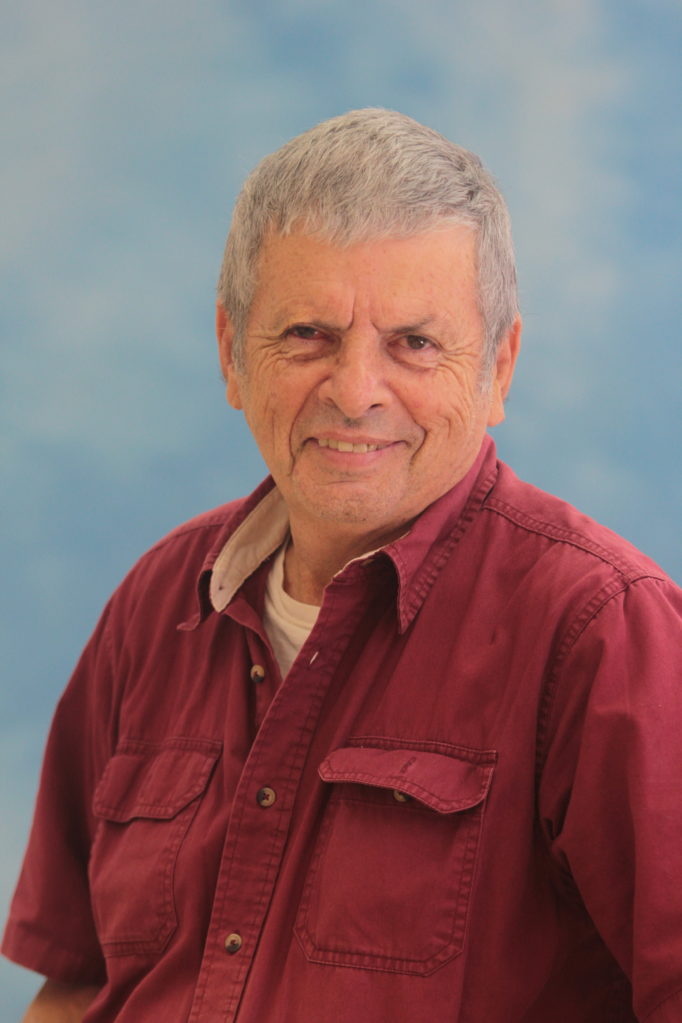Moshe Sheintuch
Personal Info
Ph.D. 1977, University of Illinois at UrbanaResearch Fields
Sustainability: Environment, Water, and Energy, Surface-Phenomena, ProcessesResearch Topics
Dynamics of Catalytic Reactors
Our research, in nonlinear reactor dynamics led to the discovery of several novel behaviors and has been a principal contribution in demonstrating the richness of kinetics instabilities and its impact on kinetic research and on design procedures of commercial reactors. Our work combines experimental, analytical and numerical studies into such behavior as steady state multiplicity, periodic and aperiodic motions and spatial symmetry breaking in a diverse array of chemical reactors: catalytic, electrochemical, biochemical, combustion and homogeneous. The recent phase of our work deals with the spontaneous emergence of spatiotemporal patterns in catalytic reactors. One such IR thermography pattern is presented below showing oscillatory behavior during catalytic oxidation of CO over Pd supported on a glass-fiber catalytic cloth. It was conducted in a continuous reactor with feed flowing perpendicular to and through the disc-shaped catalyst. Our recent work deals mainly with patterns in convection-diffusion-reaction systems, which represent fixed-bed catalytic reactor, the working-horse of many chemical and petrochemical processes. These works are of great academic interest to mathematicians and physicists, as well as of practical interest. We have recently derived criteria for the emergence of transversal patterns (perpendicular to the flow) in fixed bed reactors and verified them by three-dimensional simulations. These ideas were extended to design novel types of reactors like loop (ring-shaped) reactors. This work has been supported by the US-Israel BSF for many years now.
Predicting Adsorption and Catalytic Kinetics
In order to better understand the mechanism and limiting stages of the catalytic reactions employed in our group (CO oxidation dynamics, see above, water pollutants abatement and hydrogen production, see below) we have been developing a methodology for a detailed study of the kinetics of individual surface steps and their integration using simple theoretical models combined with DFT or molecular mechanics simulations to calculate their energies, energetic barrier and their rate. We have studied the activation energies and rate constants characterizing dissociative oxygen adsorption, dissociative water adsorption or CO oxidation on transition and noble metal surfaces using an analytical formalism previously developed by us. We also conducted research using Molecular Mechanics to study phenol adsorption on activated carbon, modeled as a collection of nanotubes and of hydrogen adsorption and activation on small palladium clusters and bulk surfaces.
Catalytic Membrane Reactors
Membrane reactors couple catalytic units with separation through a selective membrane that envelopes them in order to remove a product in equilibrium-limited reactions or to add a reactant. Our recent study of pure hydrogen generation by methane steam reforming in a scaled down autothermal unit (which was patented) follows our previous studies of dehydrogenation reaction using either a Pd/Ag or a carbon membrane. This work led to contacts with the CARENA (CAtalytic REactors based on New mAterials) and CoMETHy (Compact Multifuel-Energy to Hydrogen converter) consortiums, funded by FP7 2011-2016. Our role is in designing and building a membrane reactor for propane dehydrogenation in the former or of SR of various feedstocks in the latter project.
Environmental Catalysis
Our group is also leading in the field of catalytic abatement of water pollutants, with a highly cited review on the subject and several well cited articles on the process of adsorption on and catalytic regeneration of activated carbon, using an adsorbent impregnated with a catalyst, and on the catalytic removal of nitrates, nitrites and haloorganics from water. The latter subject has been patented, endorsed by local water company (Mekorot) and an ‘incubator’ company (http://welltodo.co.il/) has been established in 2013.
Publications
Efremenko and M. Sheintuch, “Predicting Solute Adsorption on Activated Carbon: Phenol”, Langmuir, 22, 3614-3621 (2006).
E. D. German and M. Sheintuch, “Oxygen Assisted Water Dissociation on Metal Surfaces: Kinetics and Quantum Effects”, J. Phys. Chem. C, 115,10063-10072 (2011).
A.Y. Madai and M. Sheintuch, “Demonstration of Loop Reactor Operation”, AIChEJ 54, 2413-2512 (2008); ” Reduction in greenhouse gases emission in a loop reactor adsorber: Simulations and experiments “, Chem. Eng. Sci., 65, 5392-5401 (2010).
G.A. Viswanathan, M. Sheintuch and D. Luss, “Transversal Hot Zones Formation in Catalytic Packed Bed Reactor”, Ind. Eng. Chem. Res., 47, 7509–7523 (2008).
D.S. Simakov and M. Sheintuch, “Demonstration of a Scaled-Down Autothermal Membrane Methane Reformer for Hydrogen Generation”, International Journal of Hydrogen Energy”, 34, 8866-8876 (2009).
O. Nekhamkina and M. Sheintuch,”Are 3-D models necessary to simulate packed bed reactors? Analysis of adiabatic and cooled reactors”, AIChEJ 58,3497-3503 (2012); “On spinning propagating fronts in bistable systems”, Physical Review E , 81, 055204 (Rapid Communication) (2010).
Patents
D. S. Simakov and M. Sheintuch, ” Hydrogen Production by Autothermal Heat Exchanger Packed-Bed Catalytic Methane Membrane Gas Reformer ” International Patent Application No. PCT/IL2010/000625 , filed on August 2, 2010.
U. Meital and M. Sheintuch, “Activated Carbon Cloth-Supported Bimetallic Pd-Cu Catalysts For Nitrate Removal From Water”, International Patent Application No. PCT/Il2010/000360, filed May 2010.
Moshe Sheintuch
